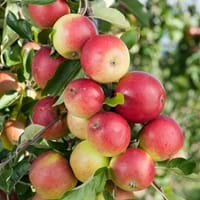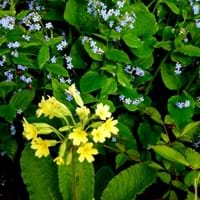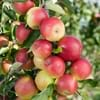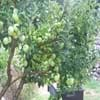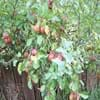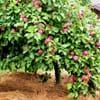Life Span
Perennial
Annual
Type
Fruit
Flowering Plants, Ornamental Plants
Origin
Hybrid origin, Eastern Europe, Southern Europe, Russia/Siberia, Southern Asia, Western Asia
Asia, Europe
Types
Not avaialable
Not Available
Habitat
Hillside, Mountain Slopes, Temperate Regions
Old fields, Open grasslands
USDA Hardiness Zone
5-8
5-8
Sunset Zone
A1, A2, A3, 8, 9, 10, 11, 12, 13, 14, 15, 16, 17, 18, 19, 20, 21, 22, 23, 24
1a, 1b, 2a, 2b, 3a, 3b, 4, 5, 6, 7, 8, 9, 10, 11, 12, 13, 14, 15, 16, 17, 18, 19, 20, 21, 22, 23, 24
Habit
Oval or Rounded
Clump-Forming
Flower Color
White
Yellow
Flower Color Modifier
Bicolor
Bicolor
Fruit Color
Red, Yellow green
Non Fruiting Plant
Leaf Color in Spring
Green
Green
Leaf Color in Summer
Green
Green
Leaf Color in Fall
Green, Light Yellow, Brown
Green
Leaf Color in Winter
Light Green
Light Green
Plant Season
Spring, Fall
Summer
Sunlight
Full Sun, Partial Sun, Partial shade
Full Sun, Partial Sun
Growth Rate
Medium
Medium
Type of Soil
Clay, Loam, Sand
Loam, Sand
The pH of Soil
Acidic, Neutral
Acidic, Neutral, Alkaline
Soil Drainage
Well drained
Well drained
Bloom Time
Spring, Late Spring
Early Summer, Summer, Late Summer
Tolerances
Drought
Variety of soil types
Where to Plant?
Ground
Container, Ground, Pot
How to Plant?
Grafting, Seedlings, Transplanting
Divison, Seedlings, Stem Planting
Plant Maintenance
Medium
Low
Watering Requirements
Medium
Average Water Needs, Do Not over Water, Never Over-water, Requires regular watering, Water more in summer
In Summer
Lots of watering
Lots of watering
In Spring
Moderate
Moderate
In Winter
Average Water
Average Water
Soil pH
Acidic, Neutral
Acidic, Neutral, Alkaline
Soil Type
Clay, Loam, Sand
Loam, Sand
Soil Drainage Capacity
Well drained
Well drained
Sun Exposure
Full Sun, Partial Sun, Partial shade
Full Sun, Partial Sun
Pruning
Remove damaged leaves, Remove dead branches, Remove dead leaves
Remove damaged leaves, Remove dead branches, Remove dead leaves, Remove dead or diseased plant parts
Fertilizers
All-Purpose Liquid Fertilizer
All-Purpose Liquid Fertilizer, fertilize in growing season
Pests and Diseases
Red blotch
Slugs, Snails
Plant Tolerance
Drought
Variety of soil types
Flower Petal Number
Single
Single
Foliage Texture
Medium
Fine
Foliage Sheen
Matte
Matte
Allergy
Mouth itching, Throat itching
Abdominal pain, Constipation, Diarrhea, Skin irritation
Aesthetic Uses
Not Used For Aesthetic Purpose
Beautification, Borders, Landscape Designing, Showy Purposes
Beauty Benefits
Not Available
Good for skin, Making cosmetics, Stops hair loss
Environmental Uses
Air purification
Air purification, Food for insects, Versatility
Medicinal Uses
Cancer, constipation, Diabetes, Diarrhea, Dysentry, Fever, Heart problems, Tooth ache
Eczema
Part of Plant Used
Fruits
Root
Other Uses
Used As Food, Wood is used for making furniture
Decoration Purposes, Medicinal oil, Showy Purposes, Used as Ornamental plant, Used for its medicinal properties
Used As Indoor Plant
No
Yes
Used As Outdoor Plant
Yes
Yes
Garden Design
Edible, Feature Plant, Fruit / Fruit Tree, Topiary / Bonsai / Espalier
Edging, Feature Plant, Groundcover, Mixed Border
Botanical Name
Malus domestica
Primula veris
Common Name
Apple, Cooking Apple, Crimson King Apple, Red Cider Apple, Red Eating Apple
cowslip, common cowslip, cowslip primrose
In Hindi
Cider Apple
cowslip primrose
In German
Cider Apple
Echte Schlüsselblume
In French
Cider Apple
Brérelle, le Coqueluchon, le Coucou, l’Herbe à la paralysie, l’Herbe de saint Paul, la Primerolle, la Primevère de printemps ou la Printanière
In Spanish
sidra de manzana
Primula veris
In Greek
Cider Apple
πασχαλίτσα primrose
In Portuguese
sidra de maçã
prímula cowslip
In Polish
Cider Apple
Pierwiosnek lekarski
In Latin
Pupillam cisere
cowslip Primrose
Phylum
Magnoliophyta
Magnoliophyta
Class
Magnoliopsida
Magnoliopsida
Family
Rosaceae
Onagraceae
Clade
Angiosperms, Eudicots, Rosids
Angiosperms, Eudicots, Rosids
Tribe
Not Available
Onagreae
Subfamily
Not Available
Onagroideae
Number of Species
Not Available
Importance of Cider Apple and Cowslip Primrose
Want to have the most appropriate plant for your garden? You might want to know the importance of Cider Apple and Cowslip Primrose. Basically, these two plants vary in many aspects. Compare Cider Apple and Cowslip Primrose as they differ in many characteristics such as their life, care, benefits, facts, etc. Every gardener must at least have the slightest clue about the plants he wants to plant in his garden. Compare their benefits, which differ in many ways like facts and uses. The medicinal use of Cider Apple is Cancer, constipation, Diabetes, Diarrhea, Dysentry, Fever, Heart problems and Tooth ache whereas of Cowslip Primrose is Eczema. Cider Apple has beauty benefits as follows: Not Available while Cowslip Primrose has beauty benefits as follows: Not Available.
Compare Facts of Cider Apple vs Cowslip Primrose
How to choose the best garden plant for your garden depending upon its facts? Here garden plant comparison will help you to solve this query. Compare the facts of Cider Apple vs Cowslip Primrose and know which one to choose. As garden plants have benefits and other uses, allergy is also a major drawback of plants for some people. Allergic reactions of Cider Apple are Mouth itching and Throat itching whereas of Cowslip Primrose have Abdominal pain, Constipation, Diarrhea and Skin irritation respectively. Having a fruit bearing plant in your garden can be a plus point of your garden. Cider Apple has showy fruits and Cowslip Primrose has no showy fruits. Also Cider Apple is not flowering and Cowslip Primrose is flowering. You can compare Cider Apple and Cowslip Primrose facts and facts of other plants too.
